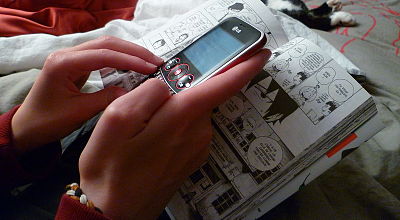Sexting: Youth Pastors Deal With New Challenge
If parents and student leaders think their precious teens aren’t sending naked pictures of themselves to their boyfriends and girlfriends, they need to think again. It’s happening.
Students (teens age 12-17) are using their mobile phones as portable pornography devices.
There’s a name for this: sexting. It’s defined as sending sexually suggestive messages or photos via text messaging on mobile phones.
Sexting went mainstream in June when the national news outlets reported New York Representative Anthony D. Weiner sent suggestive photographs of himself to women he met over the Internet. Some of them returned the “favor,” setting off a firestorm of controversy. Calls for his resignation from Congress came from both Democrats and Republicans.
While Weiner was adamant that he would not resign his seat, claiming he had broken no laws, pressure from his Democratic colleagues led to his June 16 resignation.
This was an adult who certainly should use better judgment, but teens need a good dose of judgment as well. They are old enough to know better, but sadly, studies show they aren’t doing better.
A survey conducted by The Pew Internet and American Life Project in 2009 including only minors (age 12-17) said 4 percent of mobile phone-owning teens say they have sent sexually suggestive nude or nearly nude images or videos of themselves to someone else via text message, and 15 percent have received such messages.
The National Campaign to Prevent Teen and Unplanned Pregnancy* and CosmoGirl.com* commissioned a survey of teenagers age 13-19 to explore electronic activity in 2008. (Note this study was more than three years ago.)
This survey said that 22 percent of girls and 18 percent of boys have sent nude or seminude pictures or videos of themselves via mobile phone. The survey also said that 37 percent of girls and 40 percent of boys said they had sent sexually suggestive messages to someone.
Mandy Crow, editor of EC, a student devotional magazine published by LifeWay, said church kids are not immune.
“We talk with teens and student leaders often,” she said. “We hear this everywhere. It’s happening with church kids just like unchurched kids.
“They seem to think it’s flirty or funny,” Crow said. “They just don’t see the long-term consequences.”
A panel of girls’ ministry leaders talked about sexting during a large group session at the 2011 Girls’ Ministry Forum. LifeWay’s Girls Ministry Director Pam Gibbs acknowledged it’s a conversation church leaders must be involved in.
“These young girls are sometimes naive,” Gibbs said. “Often, they are good kids and just want to be popular. They don’t get it that this is something that can follow them for the rest of their lives.”
The panel agreed that sexting is happening with church kids. It often comes out of peer pressure or boyfriend/girlfriend insistence.
According to the NCPTUP study (relating to those who admitted to having sent or posted sexually suggestive content):
Seventy-one percent of teenage girls and 67 percent of teenage guys who have sent or posted sexually suggestive content say they have sent or posted this content to a boyfriend or girlfriend.
Twenty-one percent of teenage girls and 39 percent of teenage boys say they have sent such content to someone they wanted to date or “hook up with” (euphemism for casual sexual encounter).
Forty-four percent of both teenage girls and teenage boys say it is common for sexually suggestive text messages to be shared with people other than the intended recipient.
Thirty-six percent of teenage girls and 39 percent of teenage boys say it is common for nude or seminude photos to be shared with people other than the intended recipient.
MTV,* a television network known for programming related to youth culture, aired “Sexting In America: When Privates Go Public.”
Two young adults were profiled. At the time of the program, one was a 19-year-old girl who, at age 16, sent a nude photograph of herself to an ex-boyfriend who said he would get back together with her if she would send it. The boy instead sent the photo to everybody in his contact list and soon her photo was all over the school.
She said she not only felt betrayed, but experienced “brutal and terrible harassment” from classmates that included vulgar name-calling.
A young man, 20 when the program was made, received naked pictures from his girlfriend when he was 17. They had a fight and he retaliated by calling up the picture on his cell phone and hitting the “send all” on his contact list. The girl’s picture went out to more than 70 people, including friends, teachers, parents and grandparents.
But by that time, he’d had his 18th birthday—still in high school but legally an adult. He was arrested for distributing child pornography—she was still 17—and put on five years’ probation. In addition, he was required to register on the public sex offender list.
He said he was kicked out of college, can’t find a job and can’t live with his dad because his dad’s house is near a school. He is required to attend a class for sex offenders, where, as he said, he’s sitting in a room with “perverts and rapists.”
Unless his attorney is successful in getting him taken off the list, he could remain on the sex offender list until he is in his 40s.
Depending on state laws, being on a sex offender list places limits on where a person can live and with whom they can associate. It also can limit the activities they can legally do.
These two young adults profiled on the MTV program didn’t claim to be Christians or profess involvement in a church, but “good church kids” are not immune to the pressure of sexting.
Crow said it’s important that student leaders and parents be proactive in dealing with sexting.
“Bottom line, it’s child pornography,” she said.
“Student leaders need to help parents know what to do and how to talk to their teenagers about sexting,” she said. “Parents need to be empowered to speak out. The issue isn’t going away.”
While laws vary from state to state, the person creating and sending the image is possibly looking at charges of child pornography and sexual exploitation of a minor. Being convicted of those charges can carry up to 20 years in prison.
While almost two dozen states are considering changes to laws that would separate sexting from the same category as child pornography, that hasn’t happened yet.
Crow said, “Helping students understand that once they hit ‘send’ they have lost all control of where that photo or video goes is a place to begin the conversation.”




























































